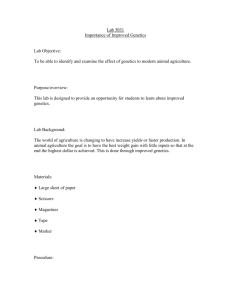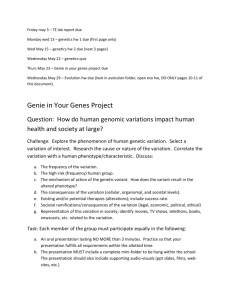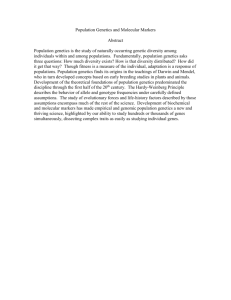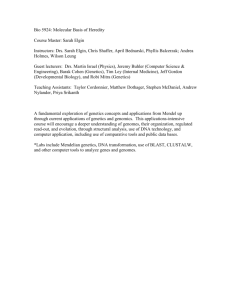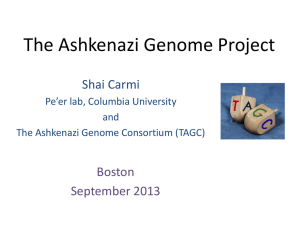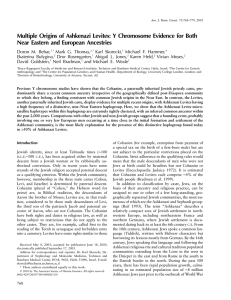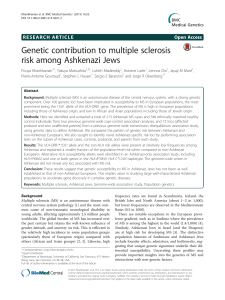**** ** PowerPoint - Columbia University
advertisement
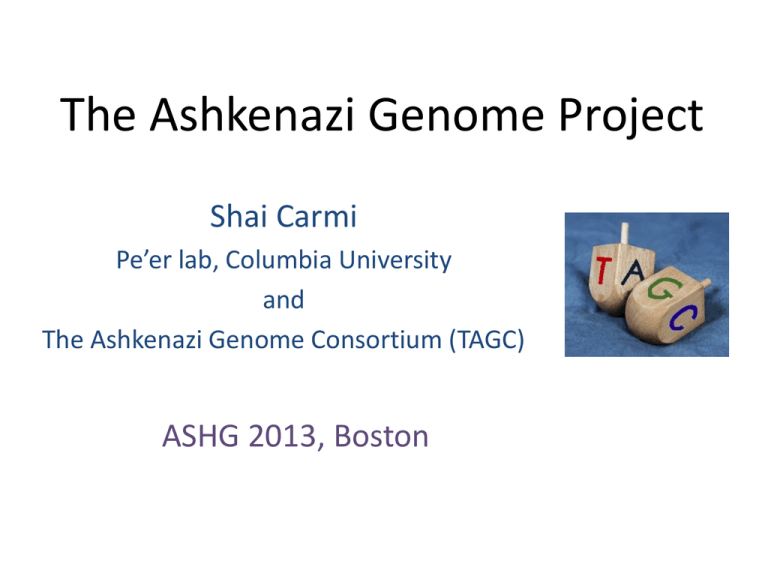
The Ashkenazi Genome Project Shai Carmi Pe’er lab, Columbia University and The Ashkenazi Genome Consortium (TAGC) ASHG 2013, Boston Why Study Ashkenazi Jewish Genetics? Unique demography conducive to medical genetics o o o o A severe founder event; isolation Large current size Many genetic risk factors discovered Sequencing panel missing Palamara et al., 2012 Why Study Ashkenazi Jewish Genetics? Unique demography conducive to medical genetics Population genetics o Insight on both European and Middle-Eastern past AJ Europeans Jewish, non-AJ MiddleEastern Atzmon et al., 2010 Price et al., 2008 Olshen et al., 2008 Need et al., 2009 Kopelman et al., 2009 Behar et al., 2010 Bray et al., 2010 Guha et al., 2012 The Ashkenazi Genome Consortium NY area labs interested in specific diseases Study design: • 128 unrelated healthy controls • PCA-validated AJ ancestry • High-coverage whole-genome sequencing • Complete Genomics Quantify utility in medical genetics Learn about population history Variant Discovery & Screening • Comparison cohort: 26 Flemish individuals from Belgium o AJ have more novel variants than FL o Variant discovery in AJ predicted to decay faster Method: Gravel et al., 2011 Variant Discovery & Screening • Comparison cohort: 26 Flemish individuals from Belgium o Most novel AJ variants do not appear in a FL panel Variant Discovery & Screening • Comparison cohort: 26 Flemish individuals from Belgium o Most novel AJ variants do not appear in a FL panel o Many novel AJ variants appear in an AJ panel Variant Discovery & Screening • Comparison cohort: 26 Flemish individuals from Belgium o Most novel AJ variants do not appear in a FL panel o Many novel AJ variants appear in an AJ panel Abundance of Genetic Sharing • Sharing common in AJ (but not in FL or between AJ-FL) • Long segments shared with the panel cover the majority of a typical AJ genome >3cM Theory predicts the average coverage: 1 − 1 − 𝑐max 1 − 𝑒 −𝑛 𝑛0 2 Recent AJ History Method: Palamara et al., 2012 The Joint Allele Frequency Spectrum • Allele frequencies correlated, but populations distinct • Fit a historical model to the AFS. A Model Time (years ago) Present AJ FL Time (years ago) The Inferred Model 6500 52k Out-of-Africa 2300 Middle-East 1800 10.8k 1.7k Present 55% Jewish diaspora AJ Method: Gutenkunst et al., 2009 FL Summary • Data: 128 high coverage AJ genomes • Medical genetics: Useful for genome screening and imputation • Population genetics: o Recent severe bottleneck and rapid expansion o Over 50% European ancestry in AJ o Europeans diverged from ME only ≈10-20 kya Thank you! TAGC consortium members: Columbia University Computer Science: Itsik Pe’er Fillan Grady, Ethan Kochav, James Xue Shlomo Hershkop Long-Island Jewish Medical Center: Todd Lencz, Semanti Mukherjee, Saurav Guha Columbia University Medical Center: Lorraine Clark, Xinmin Liu Albert Einstein College of Medicine: Gil Atzmon, Harry Ostrer, Nir Barzilai, Kinnari Upadhyay, Danny Ben-Avraham Mount Sinai School of Medicine: Inga Peter, Laurie Ozelius Memorial Sloan Kettering Cancer Center: Ken Offit, Joseph Vijai Yale School of Medicine: Judy Cho, Ken Hui, Monica Bowen The Hebrew University of Jerusalem: Ariel Darvasi Beth Israel Medical Center: Susan Bressman VIB, Gent, Belgium Herwig Van Marck, Stephane Plaisance Complete Genomics Omicia Funding: Human Frontiers Science program




